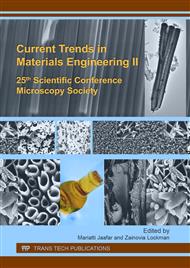p.50
p.54
p.58
p.62
p.66
p.70
p.74
p.79
p.83
Effect of Different Solutions on Hydrothermal Treatment of β-Tricalcium Phosphate Scaffold
Abstract:
Carbonate apatite would be ideal for bone substitute due to its composition of 4-8% carbonate similar to bone mineral. The purpose of the present study was to produce carbonate apatite scaffold by using hydrothermal treatment of β-TCP scaffold as a precursor. The effect of different solutions on hydrothermal treatment was studied. The microstructure of scaffold before and after hydrothermal were characterized by scanning electron microscopy (SEM). It is observed that surface characteristics are governed by the types of immersion solution. The typical smooth surface of the β-TCP scaffold was observed before hydrothermal. Different morphology was observed after hydrothermal in different solutions. X-Ray Diffraction (XRD) pattern indicates that the peak of apatite with low intensities present after hydrothermal treatment in sodium hydrogen carbonate solution.
Info:
Periodical:
Pages:
66-69
Citation:
Online since:
September 2017
Authors:
Keywords:
Price:
Сopyright:
© 2017 Trans Tech Publications Ltd. All Rights Reserved
Share:
Citation:


